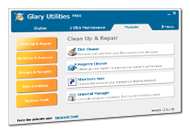Happy Holidays: Windows XP optimization utilities
Wednesday, December 24, 2008
Is your PC too slow these days? Is it locking up or doing other weird things? Before you begin furiously uninstalling everything and buying new hardware, you may want to try some of these Windows XP software solutions.
 First, let’s acknowledge poor Windows Vista
First, let’s acknowledge poor Windows Vista
The first step to optimizing Windows XP to run most efficiently is to be thankful that you have avoided resources-hungry Windows Vista, purposefully or by chance. Microsoft has finally conceded that Vista is a flop: “Microsoft Extends Windows XP Cutoff Date” (again). Windows XP will continue to be distributed to large OEMs until at least July 31, 2009. Next for the Windows OS series is Windows 7, possibly making its debut as early as late 2009. The word on the street is: “Pressure mounts for Microsoft to deliver with Windows 7.”
Ways to speed up Windows XP
After several months of laziness, I was feeling like becoming more vigilant about PC cleanup again. So, I have identified some of the latest and greatest free applications to help speed things up. If you are running Windows XP, below are some high-quality freeware utilities and information that will help you optimize it. (Note: Some programs also work with Vista.)
You might be interested in a couple of articles by Bill Mullins regarding Windows processes/services that run in the background. Mullins explains what they are and recommends which should be enabled/disabled to speed up your PC: “Bare Minimum Processes for Windows XP to Run Correctly” and “Speedup Your PC – Turn Off Unnecessary Services in XP.” He has a number of interesting articles in his blog.
Microsoft also offers this article for Windows XP SP3 and Windows Vista: “5 ways to speed up your PC,” which describes ways to do the following:
- Free up disk space
- Speed up access to data
- Detect and repair disk errors
- Protect your computer against spyware
- Learn all about ReadyBoost
But let’s ignore the Microsoft way and move on to more effective third-party Windows utilities instead.
Regularly backup your Windows registry
Before doing anything else, it’s a good idea to run ERUNT (Emergency Recovery Utility NT) to backup your Windows registry. You can set ERUNT to run at bootup and use it to store numerous registry backups. If the Windows registry gets corrupted, it can mess up your entire system. With ERUNT’s restore folders, you can restore your NT-based system to its full glory. (Alternatively, you can suffer through the Microsoft way to back up and restore the registry in Windows.)
 Cleanly uninstall useless crap
Cleanly uninstall useless crap
You know when you uninstall a program from Windows and it leaves little pieces of crap all over your PC in various folders and in the registry? Revo Uninstaller is nice freeware that tries to fix this shortcoming of Windows. It has four uninstall modes, with the first level being a standard Windows uninstall and the fourth level being the most thorough. In the most thorough mode, Revo searches the hard drive and the registry for anything related to the program that you are uninstalling. It provides you with a list and asks you what you want to delete. I uninstalled a bunch of programs that I never use. It deleted every trace. Revo Uninstaller also has a few built-in utilities that I have not used.
Easily access Windows system utilities and see autoruns
XPSysPad is a Windows system monitoring utility that allows easy access to Windows system information and Windows system utilities, such as the individual control panel applets, as well as putting the “hidden” applications in Windows at your fingertips. XP Syspad also recovers lost Windows & MS-Office product key. This is a great little piece of software.
AutoRuns for Windows has the most comprehensive knowledge of auto-starting locations of any startup monitor. It shows you what programs are configured to run during system bootup or login, and shows you the entries in the order Windows processes them. You’ll probably be surprised at how many executables are launched automatically!
Checking for programs needlessly running at startup is an important step when optimizing your computer, as is checking for spyware/adware that can eat up resources. The full system care programs below can help with that.
 Full system care, disk cleanup and defragmentation
Full system care, disk cleanup and defragmentation
I’ve used CCleaner in the past, but now I prefer IObit’s Advanced SystemCare Free v3 (the new, improved version of Advanced Windows Care) for comprehensive PC tidying. You can use Advanced SystemCare to cleanup the registry and turn off a lot of the Startup programs that try to automatically run in the background. With Advanced SystemCare v3, they really improved the interface and it has several new features and utilities, like an optimizer for Firefox and your TCP/IP connection, etc. The built-in registry scanner seems to find lots more stuff than before. The registry scanner also has a built-in feature called Deep Scan, but it is disabled and you need to buy the paid version to activate it. The new version is pretty nice and I will continue to use it, along with Glary Utilities (see below).
Note: Advanced SystemCare integrates with IObit’s Smart Defrag, which also has a real-time defrag feature (though the real-time part seems a bit terrifying to me). If you install ASC first, it will ask you to install Smart Defrag when you choose that Tuneup option under Utilities.
Glary Utilities is another freebie that does lots of stuff. Some of its functionality duplicates the features of Advanced SystemCare, but I think it’s nice to be able to run both, to kind of check each other’s work.  A paid version allows Glary Utilities to work with a built-in scheduler as opposed to manual mode in the free version. Personally, I would never use anything but manual mode anyway. The registry cleaner might be better than ASC, but both seem to be very thorough and have undo features. It also provides easy access to some of the main built-in Windows utilities. For example, it makes it very easy to set a Restoration Point, access the Windows Disk Defragger, etc. It makes Windows utilities easier to find than digging through the Windows menus (but if you have XPSysPad this is a moot point anyway).
A paid version allows Glary Utilities to work with a built-in scheduler as opposed to manual mode in the free version. Personally, I would never use anything but manual mode anyway. The registry cleaner might be better than ASC, but both seem to be very thorough and have undo features. It also provides easy access to some of the main built-in Windows utilities. For example, it makes it very easy to set a Restoration Point, access the Windows Disk Defragger, etc. It makes Windows utilities easier to find than digging through the Windows menus (but if you have XPSysPad this is a moot point anyway).
Glary Utilities also has a Disk Cleaner, Shortcut Fixer, Startup Manager, Registry Defragger, File Shredder, File Encrypter/Decrypter, File Splitter/Joiner, and more. It has an Uninstall Manager, but I haven’t tried it since I like Revo Uninstaller. Nice simple user interface. On the top menu, I tend to use Modules instead of 1-Click Maintenance. I think the 1-Click Maintenance section was designed to be used with the scheduler. I also went into the Settings menu and turned off the feature to have the Utilities load automatically when Windows starts.
Anti-spyware and bot searching
SUPERAntiSpyware is the best anti-adware/spyware program that I have found. It found many more items than AdAware. I run the free version manually every now and then, but I’ve disabled all of the auto features.  If you only want to run it in manual mode, sift through the options to turn off the option to start when Windows boots up. I think you will be amazed at the amount of crap it finds on your PC. It produces a list. Look through the list to make sure that it is not trying to delete a legitimate program because of a false positive. It found one false positive on my PC, an old DOS game that I haven’t played in ages. It can take a while to do a full scan of your PC, so turn it loose when you can let it run for a while. It took nearly an hour to scan my PC.
If you only want to run it in manual mode, sift through the options to turn off the option to start when Windows boots up. I think you will be amazed at the amount of crap it finds on your PC. It produces a list. Look through the list to make sure that it is not trying to delete a legitimate program because of a false positive. It found one false positive on my PC, an old DOS game that I haven’t played in ages. It can take a while to do a full scan of your PC, so turn it loose when you can let it run for a while. It took nearly an hour to scan my PC.
Here are a few related software titles: Spybot Search & Destroy is another good anti-spyware program. BotHunter is a utility I haven’t used yet but it seems like an interesting and useful program for network scanning and malware infection monitoring. Also check out the matousec.com Firewall Challenge to see how well your software firewall of choice is protecting you (or be sure to download a good one if you don’t have a firewall).
Get the latest software drivers
I haven’t yet tried it, but my dad uses DriverMax for updating the drivers on his PC and he says it works really well. I may check it out. Apparently you just create a free account, log in, and start downloading driver updates. I usually just manually update individual drivers as needed, but this automated, system-wide driver enlightenment sounds nice.
On a more general software note, I like to save old versions of software, in case they become useful at a later date. Here are some sites that archive lots of software, so you can install old versions if you want to: OldVersion.com, OldApps.com and Old-Versions.net.
A marginally useful note about Windows virtual memory
The system care utilities above should properly handle your computer’s temp files and provide general disk cleanup, but if you’re still having memory or performance problems, you might also try manually checking and possibly changing the size of your virtual memory / paging file. In Control Panel > System > Advanced, click [Settings] in the “Performance” Section. In the Advanced tab of Performance Options, the current total physical size of all page files that may be in existence is shown. Click [Change] to make settings for the Virtual memory operation. If the system is managing this, you may want to change to a custom size that’s either the same or 2 to 2.5x the amount of RAM you have installed (a decent rule of thumb). It might help performance to have such a custom memory range established, though I believe there are a lot of myths/opinions about what actually helps with page file settings and what is useless. And I’m not an expert on what is effective and what is voodoo for Windows page files.
(Thanks to my dad for software recommendations included in this post.)
Happy Holidays, everyone!